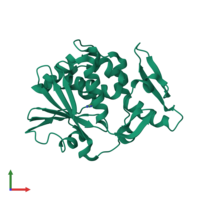| Trichosanthine | ||

| ||
| Caractéristiques générales | ||
|---|---|---|
| Fonction | protéine inactivant les ribosomes | |
| Distribution | racines | |
| N° EC | 3.2.2.22 | |
| PDB | 1QD2 | |
| Trichosanthes kirilowii | ||
La trichosanthine (TCS) est une protéine inactivant les ribosomes[1] (en anglais : ribosome-inactivating protein) de type I, trouvée dans la racine de Trichosanthes kirilowii, une plante de la famille des Cucurbitaceae[2],[3],[4]. D'une masse moléculaire de 27 kDa, elle possède une activité de N-glycosidase[5].
- (en) Priscilla Hiu-Mei Too, Meiji Kit-Wan Ma, Amanda Nga-Sze Mak et Yuen-Ting Wong, « The C-terminal fragment of the ribosomal P protein complexed to trichosanthin reveals the interaction between the ribosome-inactivating protein and the ribosome », Nucleic Acids Research, vol. 37, no 2, , p. 602–610 (ISSN 1362-4962 et 0305-1048, PMID 19073700, PMCID PMC2632931, DOI 10.1093/nar/gkn922, lire en ligne, consulté le )
- (en) Yi-Jun Gu et Zong-Xiang Xia, « Crystal structures of the complexes of trichosanthin with four substrate analogs and catalytic mechanism of RNA N-glycosidase », Proteins: Structure, Function, and Genetics, vol. 39, no 1, , p. 37–46 (ISSN 0887-3585 et 1097-0134, DOI 10.1002/(SICI)1097-0134(20000401)39:1<37::AID-PROT4>3.0.CO;2-G, lire en ligne, consulté le )
- Pang-Chui Shaw, Wah-Lun Chan, Hin-Wing Yeung et Tzi-Bun Ng, « Minireview: Trichosanthin - a protein with multiple pharmacological properties », Life Sciences, vol. 55, no 4, , p. 253–262 (ISSN 0024-3205, DOI 10.1016/0024-3205(94)00727-6, lire en ligne, consulté le )
- Pang-Chui Shaw, Ka-Ming Lee et Kam-Bo Wong, « Recent advances in trichosanthin, a ribosome-inactivating protein with multiple pharmacological properties », Toxicon, vol. 45, no 6, , p. 683–689 (ISSN 0041-0101, DOI 10.1016/j.toxicon.2004.12.024, lire en ligne, consulté le )
- J. S. Zhang et W. Y. Liu, « The mechanism of action of trichosanthin on eukaryotic ribosomes--RNA N-glycosidase activity of the cytotoxin », Nucleic Acids Research, vol. 20, no 6, , p. 1271–1275 (ISSN 0305-1048, PMID 1561083, PMCID PMC312169, DOI 10.1093/nar/20.6.1271, lire en ligne, consulté le )
